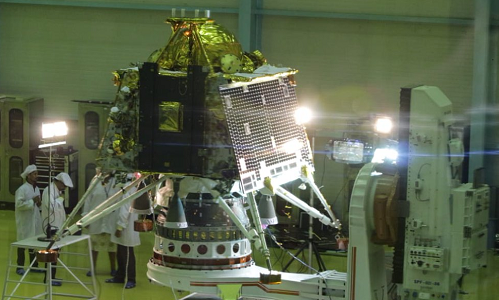The second Moon Mission of India or Chandrayaan-2 will lift off on July 15 at 2.51 am from Sriharikota and land on lunar surface on September 6. Described as the most complex space mission ever undertaken by ISRO, it will help analyse the mineral composition and undertake terrain mapping of the moon.
Bengaluru (ISJ) – India unveiled its most complex space mission ever – the second Moon Mission or Chandrayaan-2. Announcing it in Bengaluru today (June 12), K. Sivan, Chairman of India’s space agency, Indian Space Research Organisation, ISRO said, Chandrayaan-2 will lift off on July 15 at 2.51 am from Sriharikota and land on lunar surface on September 6.
The mission is expected to help in analysis of mineral composition and undertake terrain mapping of the moon. It will be the first Indian expedition to attempt soft landing on the lunar surface with home-grown technology.
“From the 30 kilometre breaking of speed to landing on the Moon’s surface will take about 15 minutes and this 15 minutes is going to be the most terrifying moment for all of us,” said Sivan. “ISRO has never undertaken such complex flight.”
Chandrayaan-2 has three modules namely Orbiter, Lander (Vikram) and Rover (Pragyan). The Orbiter and Lander modules will be interfaced mechanically and stacked together as an integrated module and accommodated inside the GSLV MK-III launch vehicle. The Rover is housed inside the Lander.
GSLV Mark-III is India’s most powerful launcher to date and has been completely designed and fabricated indigenously.
Chandrayaan-2 will attempt to soft land the lander – Vikram and rover – Pragyan or wisdom, in a high plain between two craters, Manzinus C and Simpelius N, at a latitude of about 70 degree south.
Sivan said, the Lander will separate from the Orbiter and soft land at the predetermined site close to lunar South Pole. Further, the Rover will roll out for carrying out scientific experiments on the lunar surface. Instruments are also mounted on Lander and Orbiter for carrying out scientific experiments. T
Initially, New Delhi had signed an agreement with Russian space agency Roscosmos for collaboration. But Roscosmos stepped out and India took the challenge and designed it indigenously.
The mission will cost Rs. 978 crore – Rs. 603 crore for satellite and Rs. 375 for launcher.
India had successfully launched its first mission to Moon on October 22, 2009 from its launch pad in Sriharikota in south-eastern Sriharikota. The spacecraft carried 11 scientific instruments built in India, USA, UK, Germany, Sweden and Bulgaria.
After initially orbiting around the Moon at a height of 100 km from the lunar surface for chemical, mineralogical and photo-geologic mapping of the Moon, it had been raised to 200 km during May 2009. The satellite made more than 3400 orbits around the moon and the mission was concluded when the communication with the spacecraft was lost on August 29, 2009.


